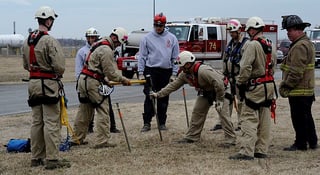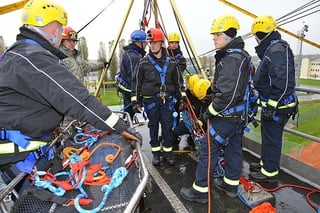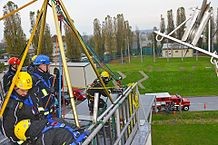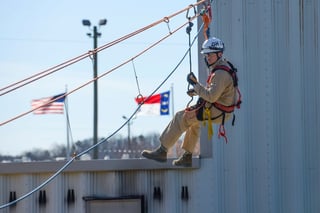After passing the state’s written test and practical skills you may feel like a certified rope technician who can take on the world. Depending on your level of training and experience you might be capable of rigging the world, maybe not. More importantly, do you know what's required to maintain your certification?
In the state of Indiana your Operations or Technician level certification never expires. Currently, from the state, there is no refresher or continuing education requirement. You could train eight hours per week or never touch a carabiner after your class and, in both cases, you remain certified.
 Is the Indiana Department of Homeland Security the only governing body for you as a rope rescue technician? NO!
Is the Indiana Department of Homeland Security the only governing body for you as a rope rescue technician? NO!
What standards apply to you as a rescuer in Indiana? MANY!
NFPA 1670 specifies requirements for your organization or authority having jurisdiction. NFPA 1006 specifies technical job performance requirements in which you should be competent. A requirement for your initial training was to meet NFPA 1006 requirements in addition to the CMC Rope Rescue Manual 4th edition. NFPA 1983, though often cited as a use standard, specifies testing and certification requirements for software and hardware used for rescue.
None of these standards states specifically that a certain amount of training is required to maintain certification or proficiency, only that you need to be competent in specific skills, though it doesn't specify how often it should be assessed or demonstrated. From NFPA 1006 we can infer that as long as you are a practicing rope rescue technician you need to be able to perform those skills.
No matter what NFPA says, it is arguable that NFPA standards are not enforceable by law. Unless adopted by Indiana code they are not criminally punishable. The counter to this argument is that if your rescue team was negligent and did not adhere to a standard and caused an injury or death, your team may be held liable for not following an industry consensus standard.
they are not criminally punishable. The counter to this argument is that if your rescue team was negligent and did not adhere to a standard and caused an injury or death, your team may be held liable for not following an industry consensus standard.
Standards developed by NFPA and similar standards development organizations (SDOs) are "voluntary consensus standards," created through procedures accredited for their consensus decision-making, openness, balance of interests represented, and fairness by the American National Standards Institute (ANSI).
Can we be more specific? YES!
OSHA may be misunderstood by some in the fire or rescue service. In a great deal of firefighter or rescue training there is not a lot conveyed about OSHA and its applicability to firefighters in the state of Indiana. OSHA states more clearly an annual training requirement for confined space rescue teams though it is not considered a very robust or demanding standard.
Relevant sections of 29 CFR 1910.146:
CFR 1910.146(k)(1)(iii)
Select a rescue team or service from those evaluated that:
1910.146(k)(1)(iii)(A)
Has the capability to reach the victim(s) within a time frame that is appropriate for the permit space hazard(s) identified;
1910.146(k)(1)(iii)(B)
Is equipped for and proficient in performing the needed rescue services;
Again, we see here general provisions that a rescuer must be capable and proficient.
The 1910.146 gets more specific:
1910.146(k)(2)(iv)
Ensure that affected employees practice making permit space rescues at least once every 12 months, by means of simulated rescue operations in which they remove dummies, manikins, or actual persons from the actual permit spaces or from representative permit spaces.
So, once every 12 months a rescue must be simulated. Also in this standard is the statement that if you had to perform a live rescue in a true emergency you may count that actual emergency as your annual rescue training.
Now, before this article gets too far in too many directions let me summarize:
· The Indiana Rope Rescue program requires no recertification or continuing education to remain certified.
· Every standard (NFPA 350, 1006, 1670 and OSHA 1910.146) applicable to rope rescue states that a rescuer must be proficient and/or competent.
Only OSHA's confined space standard states that a rescue be performed annually. You need to perform and document hours of training to meet standards but also perform highly technical skills under extremely stressful conditions.
 If your company or your department provides rescue services your employees must be prepared. One training drill annually does not create proficient rescuers. From the classes I have taught it is easy to distinguish the students who train monthly or weekly from the students who only train annually. Lacking proficiency in basic knots is a clear indication that you are not prepared for a rescue today.
If your company or your department provides rescue services your employees must be prepared. One training drill annually does not create proficient rescuers. From the classes I have taught it is easy to distinguish the students who train monthly or weekly from the students who only train annually. Lacking proficiency in basic knots is a clear indication that you are not prepared for a rescue today.
In conclusion, the National Fire Academy, in its studies and training on initial and established rapid intervention teams (firefighters who rescue trapped or lost firefighters from fires) acknowledges that this is a physically and mentally demanding task. They state that the minimum set forth by applicable standards (two firefighters performing no other task but standby to initiate rescue) is not enough to prepare the rescuer for the stressful conditions they will encounter and state that the standard for rescuing downed firefighters should be viewed as the minimum.
In this same way, standards applied to your rescue teams should be seen as the minimum. Always aim higher because your coworkers and your community demands it. Do you want you rescuing you?

 without using an extraordinary amount of time, it is an acceptable method. The goal here is to be proficient in whatever you do and be capable of doing it and 3 A.M. when called to a rescue.
without using an extraordinary amount of time, it is an acceptable method. The goal here is to be proficient in whatever you do and be capable of doing it and 3 A.M. when called to a rescue.


 they are not criminally punishable. The counter to this argument is that if your rescue team was negligent and did not adhere to a standard and caused an injury or death, your team may be held liable for not following an industry consensus standard.
they are not criminally punishable. The counter to this argument is that if your rescue team was negligent and did not adhere to a standard and caused an injury or death, your team may be held liable for not following an industry consensus standard. If your company or your department provides
If your company or your department provides 